#the spotlights?!?
Text
Conan:
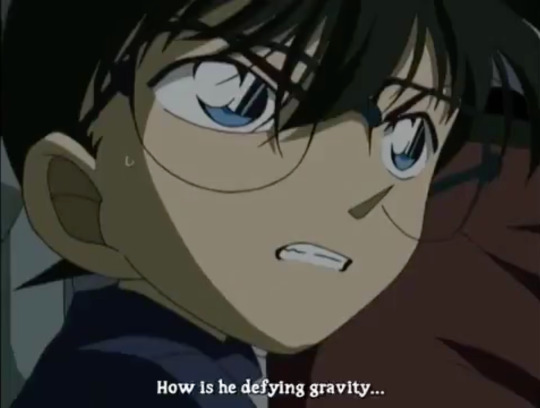
Kaito:
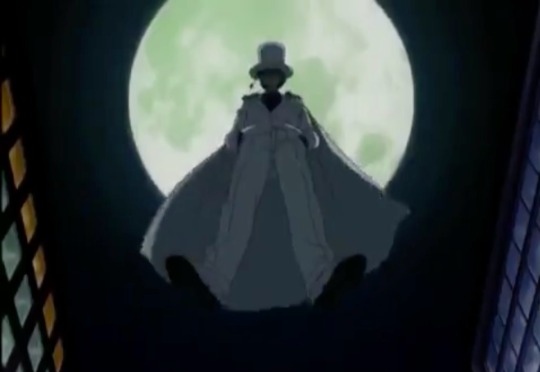
Something has changed within me~
Something is not the same

What an interesting sky pose that doesn’t look similar at all. There are no thematic ties between Elphaba and Kaito, what are you talking about. There is especially no correlation in the aforementioned song, either. They don’t both have daddy issues, don’t be silly. It’s not like magic is real in the detco universe.
…wait a minute.
#Kaito Kid is a theatre kid#pass it on#he’s so Broadway coded#the spotlights?!?#the dramatic monologues?#he lives for the audience#he is that one kid who accidentally got a lead role in Shrek the musical 7th grade and has been chasing that same high ever since#change my mind#I also headcannon him singing the lyrics#“kiss me goodbye”#as he jumps off the roof#detco#detective conan#meitantei conan#dcmk#edogawa conan#kaito kid#kaito kuroba#wicked#elphaba thropp#omg someone write a wicked au please
55 notes
·
View notes
Text
yuji had never been in gojo’s office before.
he hadn’t even known such an office existed until he and nobara convinced megumi to let them fly on nue and ended up with their faces smooching a glass window (which was now broken) and they’d been called into gojo’s office for a punishment.
it was extravagant, consisting of a dark oak desk, a floor to ceiling window, marble floors and whatnot. but mostly empty, no traces to suggest that anybody occupied it. it was devoid of any warmth and gojo’s personality—except for a frame on the desk that caught yuji’s eye.
“hey sensei, isn’t that your girlfriend?!”
gojo’s eyes flit to the photograph before he sighs, “she’s not my girlfriend anymore.”
“what?!” nobara screeches, “she was the best you could find! i mean good for her, she’s learnt her standards but now you’re definitely gonna die alone, sensei.”
even megumi’s lips were twisted into a frown.
yuji stutters, backtracking before they get kicked out of school, “wha-what she means to ask is why’d you break up? you guys were perfect for each other.” he pauses, “i think.”
he’d only seen her a few times around campus but she seemed like the sweetest person on earth, based on their few interactions. nobara definitely seemed to approve of her.
gojo props his legs up on the table, shrugging with his hands behind his head, “multiple reasons. first one, she’s out to torture me.”
“i am not.” the trio whips around to see you standing in the doorway, arms crossed with a flat expression. you lift up a bag, “you forgot your lunch. again. it’s been three times this week and it’s only wednesday.”
“as i was saying, she maimed my crotch permanently and lost any hope of mini me running around—”
“it was night and i got jumpscared by your radioactive blue eyes.”
“and then, she launched war on me and didn’t let me cuddle her.”
“because you came home bleeding with an injury that would worsen if i suffocated you.”
“and the worst of all,” gojo narrows his eyes at you, “she ate my kikifuku.”
“you’re a billionaire. just buy some more.” you shrug, placing the cover on his desk.
confusion lingers in the bemused side eyes of the students after the…interesting conversation.
“sure, they all sound heinous crimes…” yuji continues hesitantly, “but is it really worth breaking up over?”
“who said anything about breaking up? i just said that she wasn’t my girlfriend anymore.”
“now i’m even more convinced you were dropped on your head as a baby.” nobara blurts out but megumi’s eyes are already travelling to the ring on your finger, which gojo holds up to show off.
“she’s not my girlfriend anymore because she’s my wife!” he beams.
“fiancée.”
“for now.”
you roll your eyes but a fond smile blooms on your lips and gojo kisses your hand softly, “kids, say hi to mrs gojo. now i call dibs on yuji being the flower boy, megumi the ring bearer and nobara—”
“hold up. maybe we should think this through—”
“no wasting time. i need ijichi to sign the official babysitter documents for our future baby.”
“satoru!”
#gojo x reader#gojo satoru x reader#jujutsu kaisen#jjk gojo#jjk x reader#gojo satoru#jjk x you#gojo x you#gojo satoru x you#was writing something for yuji and got sidetracked#whenever it’s multicharacter (or just generally) gojo always steals the spotlight#😞😞#vera’s.jjk.library.✎
8K notes
·
View notes
Text




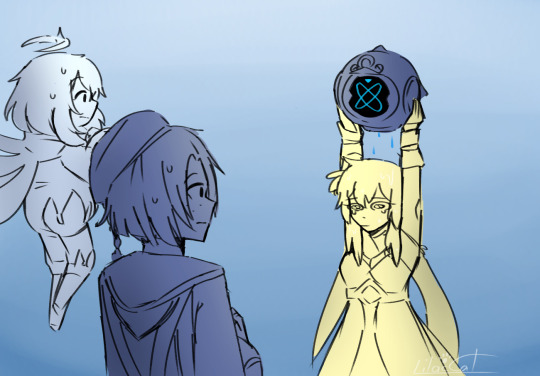
Little late on this post but me after the thelxie event
#I thank Hoyoverse for giving my boy Freminet the spotlight#he deserves some love#genshin impact#genshin#freminet#genshin freminet#paimon#genshin paimon#lumine#genshin lumine#thelxie's fantastic adventures
9K notes
·
View notes
Text

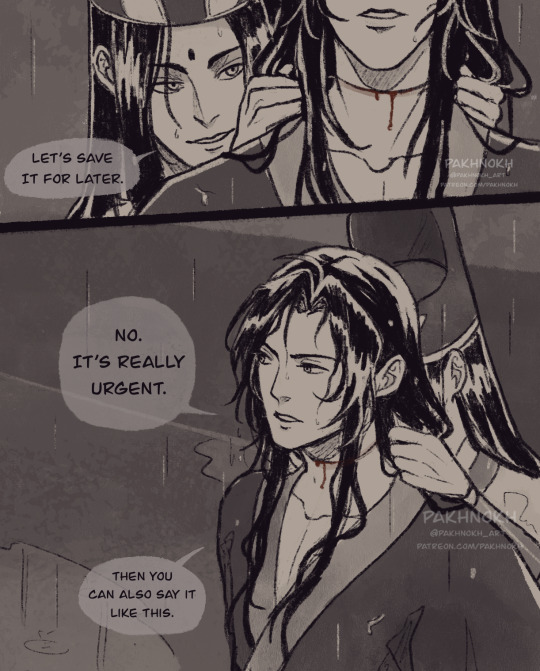

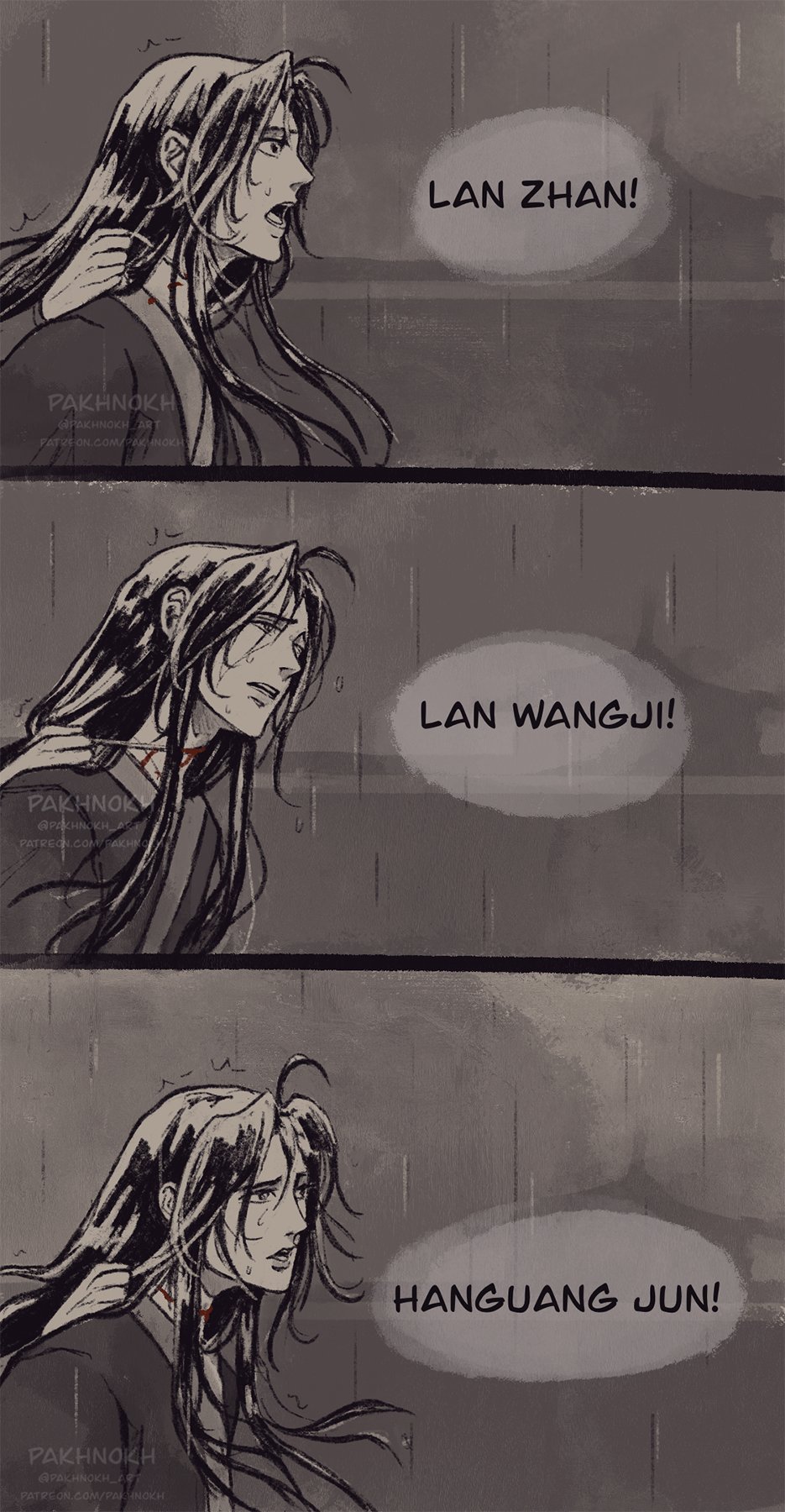


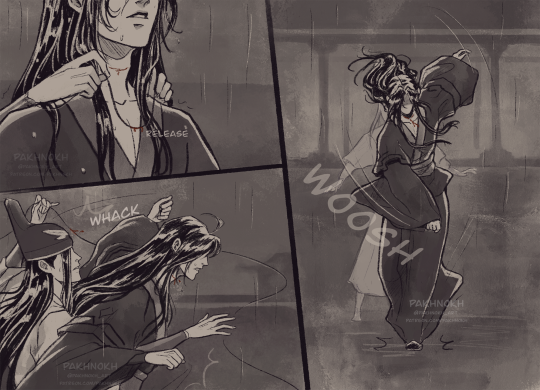
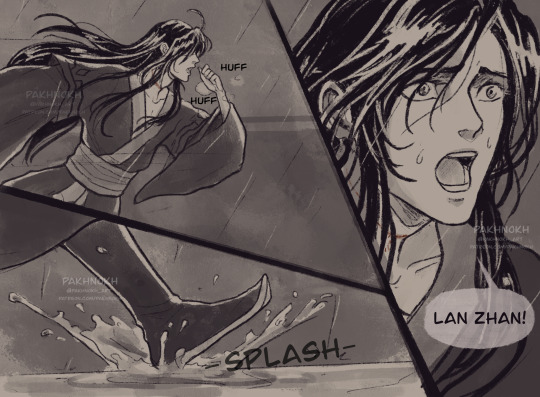

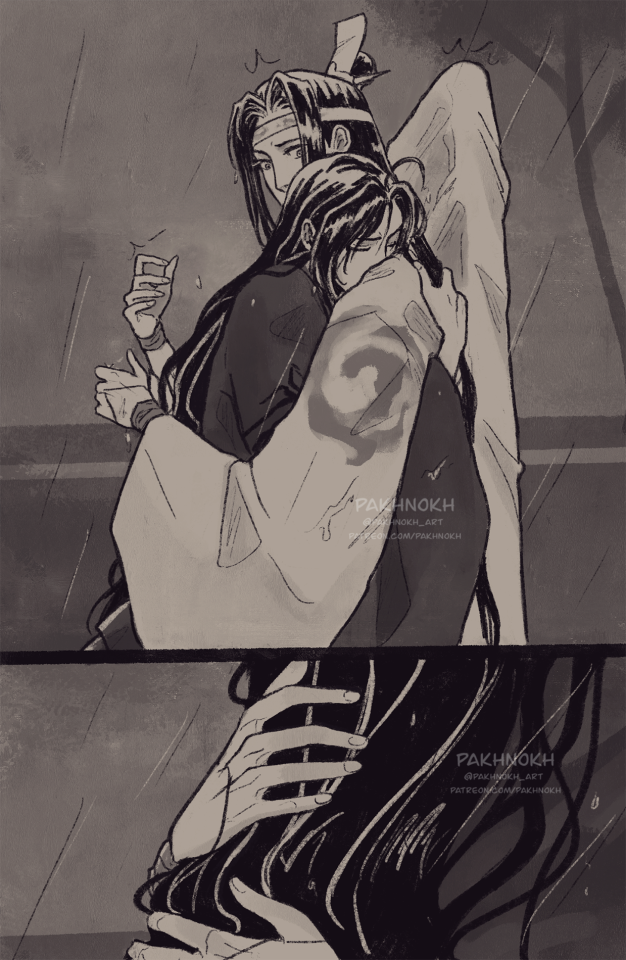
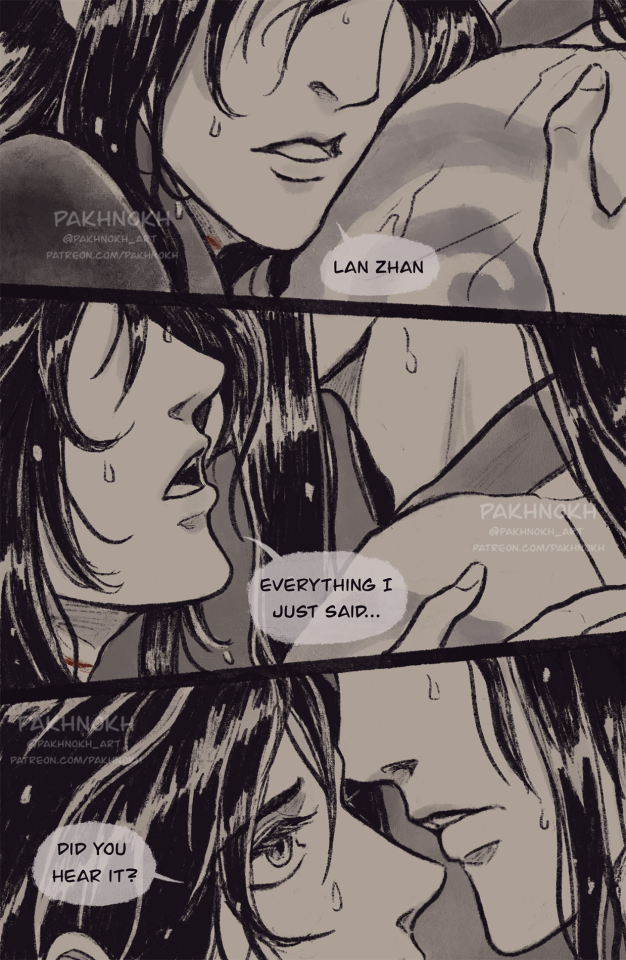
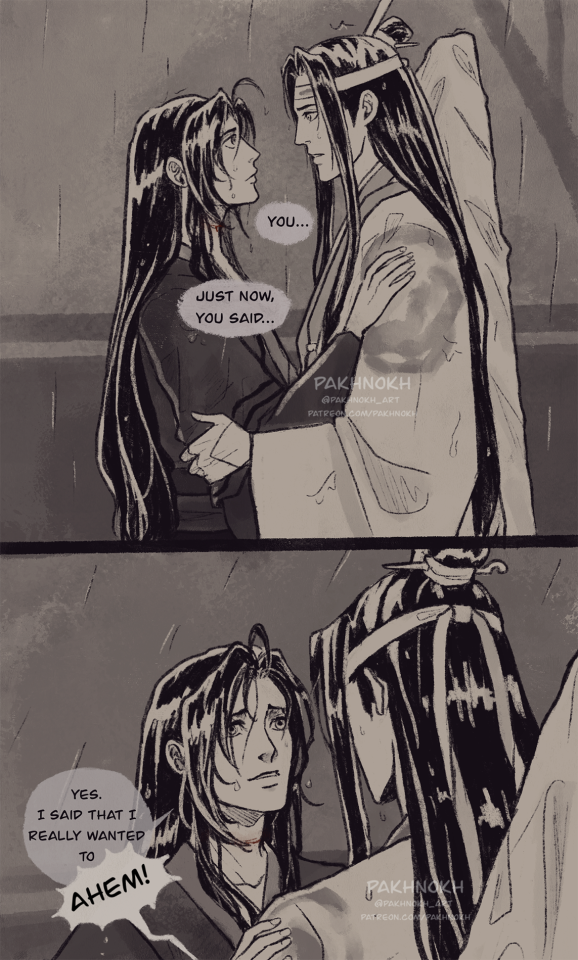

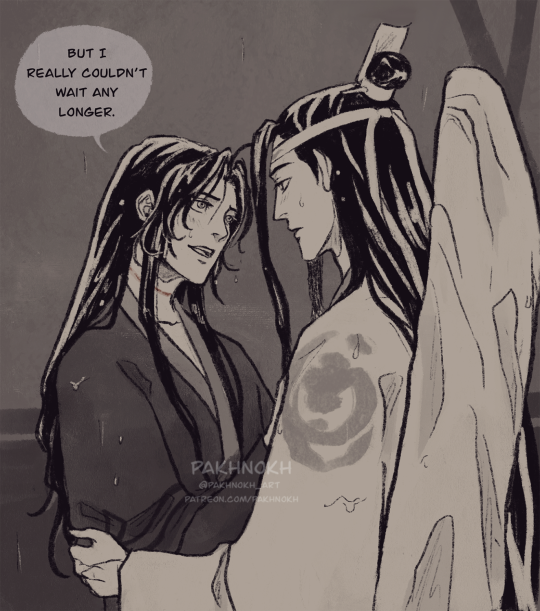
❤️ A Very Shameless Love Confession ❤️
It's finally done! After one year of creating the original sketches, I finished this comic project!
I remember having a strong cinematic visual of this scene in my mind, where it's raining and Wei Wuxian is with his hair undone. And this is the outcome hehehe
I had so much fun with this! It was such a great experience to play with the expressions, the gestures, the movement, the angles. It was a learning experience for me.
I hope you enjoy the final piece as much as I enjoyed creating it!
HAPPY UPCOMING VALENTINES DAY!
#mo dao zu shi#mdzs#wangxian#wei wuxian#lan wangji#jin guangyao#jin ling#lan xichen#grandmaster of demonic cultivation#What a way to steal the spotlight from the villain and his plot
5K notes
·
View notes
Text

The kids (Duke, Damian and Dick) are yelling in the other room
#batfam#batman#jason todd#red hood#dc#dick grayson#duke thomas#damian wayne#digital art#my art#nightwing#robin#spotlight#*taps mic* hello jason Todd fans#I wanted to draw stubble but it didn’t work out
6K notes
·
View notes
Text
a random socialite at a fundraiser: you know Bruce, that boy of yours is getting to be a little too pretty. heh.
Bruce Wayne, who was also "too pretty" at fourteen and is absolutely ready to castrate anyone who even looks at Dick directly: oh?
#bruce wayne#batman#dc#batfamily#dick grayson#dc comics#tw gross old men at fundraisers#not sure how to tag that#but yes bruce was too pretty and ughhh the angst#it's not explored enough#but you KNOW he's not letting them touch dick#alfred tried his best but he couldn't be in the spotlight WITH bruce every second#and now bruce lets them talk and smiles and walks away and then ruins them
7K notes
·
View notes
Text
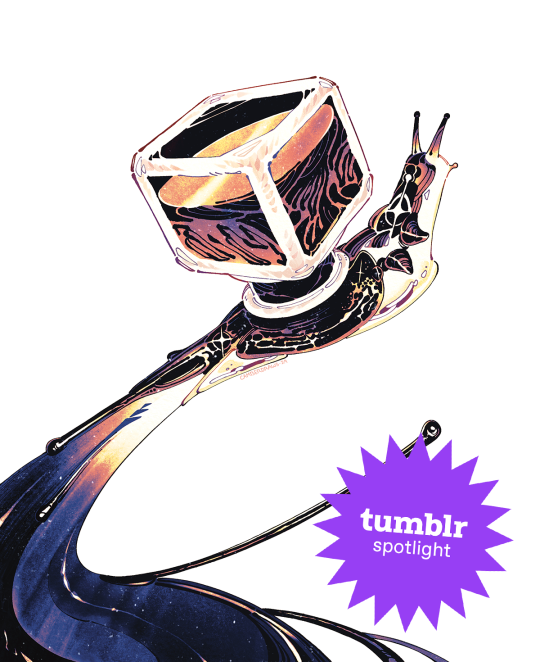
Creator Spotlight: @camberdraws
Hello! My name is Camber (any pronouns), and I’m a mixed media illustrator located in the southwestern United States. I love drawing everything, but I have a special interest in depicting strange creatures and environments, often accompanied by abstract imagery and mark-making. Professionally, I’ve worked creating concept art and 2D assets for museum exhibits, but currently, I am engaged full-time as a software developer and make standalone illustrations in my free time. I’ve been posting art on Tumblr since I was a teenager, and the site has been very welcoming towards my work to this very day!
Check out Camber’s interview below!
Did you originally have a background in art? If not, how did you start?
I’ve had an interest in drawing since I was barely sentient, but at thirteen years old I decided to become “serious” about art. I was all about reading tutorials and doing a ton of studies. I would tote my heavy instructional art books to school every single day (my poor back!) Despite all this, I decided to forgo art school in favor of a bachelor’s degree in Computer Science at my local college. Alongside my major, I received a minor in Art Studio with a specialization in fine art, which totally changed my views on creating artwork and drastically changed my style.
How has your style developed over the years?
As mentioned previously, my style did a 180 after I studied under some very skilled fine art professors! As a kid, my drawings were very realism-heavy and inspired by video game concept art. I mostly worked digitally, too. During college, I was thrown for a loop when we were instructed to do strange things like, for example, make a bunch of marks on paper using pastel, WITHOUT looking, and then turn said marks into a finished piece of art! I quickly and deeply fell in love with abstract work, and especially appreciated images that are not easily parsed by the viewer. Since then, I’ve made it my goal to combine abstract mark-making with more representational subject matter.
What is one habit you find yourself doing a lot as an artist?
Hmmm, one habit I really enjoy as an artist is strictly tracking the amount of time I spend drawing! I currently work a full-time job wholly unrelated to art, so I have to be careful with my time if I want to spend enough hours drawing each week. I created a spreadsheet that allows you to enter the amount of minutes you’ve drawn each day and calculate how much drawing time you still need to reach your weekly goal (I aim for 20 hours a week.) Having such a clear, numbers-based objective keeps me motivated to work like nothing else!
Over the years as an artist, what were your biggest inspirations behind your creativity?
I know this is a common inspiration, but Hayao Miyazaki’s work has been rewiring my neurons since I was a child. Seemingly all of my artistic interests can be summed up by the movie Princess Mononoke: it has strange/abstract creature designs, a strong focus on nature and environmental storytelling, and a mix of dark and hopeful themes. Additionally, I’ve been deeply inspired by video game series such as Zelda, Okami, Pikmin, and Dark Souls. But arguably, none of these have influenced me more than Pokemon! I’ve been drawing Pokemon since I could barely hold a pencil, and I haven’t stopped since! I believe my love of designing creatures originated with my endless deluge of Pokemon fanart during my childhood.
What is a medium that you have always been intrigued by but would never use yourself?
I’ve always been fascinated by 3D mediums and am so tempted to try them out! Whether that’s 3D models created digitally or sculptures made from clay, I profoundly admire artists who have this skill. Oftentimes, it feels like I don’t have time to delve into a totally different artistic paradigm. However, I feel very strongly that learning new skills can enrich your current work. I should take that advice and someday give 3D mediums a shot!
What is a recent creative project that you are proud of?
I am in the process of creating an art book (a dream of mine!) and have been executing smaller drawings of concepts I find interesting from both a visual and storytelling standpoint. A recent drawing for said book is that of a snail made of ink with an ink bottle as a shell, and it went absolutely viral! I’ve never had an experience like this as an artist before and it has been spectacular! I was able to open a shop using my newly acquired art printer and sell many prints of my snail. Creating something original, directly stemming from my interests, and having that resonate with so many people has been unreal. I couldn’t ask for more as an artist!
What advice would you give to younger you about making art that’s personal or truthful to your own experiences?
I would tell my younger self to chill out and experiment more! I was so caught up in the idea that I needed to have a realistic style to be considered “good.” I also believed that technical skill was the only measure of how worthy my art was. That’s not to say technical skill doesn’t matter, but I now firmly believe the creativity and voice of your ideas far outweigh the skill of execution in terms of importance. Technical skills should elevate ideas, not the other way around. Once I began to revel in strange ideas and stories for my work, depicted oftentimes in odd styles or mediums, I truly found my voice as an artist.
Who on Tumblr inspires you and why?
My peers here on Tumblr inspire me more than anything! Sharing my work with contemporaries and giving each other support brings me joy like no other, and keeps me motivated to continue creating. I wouldn’t be where I am today without them! @beetlestench, @theogm-art, @trustyalt, @ratwednesday, @phantom-nisnow, @svltart, @mintsdraws, @mothhh-hh, @jupiterweathers, @thesewispsofsmoke, @picoffee, @fetchiko, @kaisei-ink, and @pine-niidles just to name only a few!
Thanks for stopping by, Camber! If you haven’t seen their Meet the Artist piece, check it out here. For more of Camber’s work, follow their Tumblr, @camberdraws!
1K notes
·
View notes
Photo
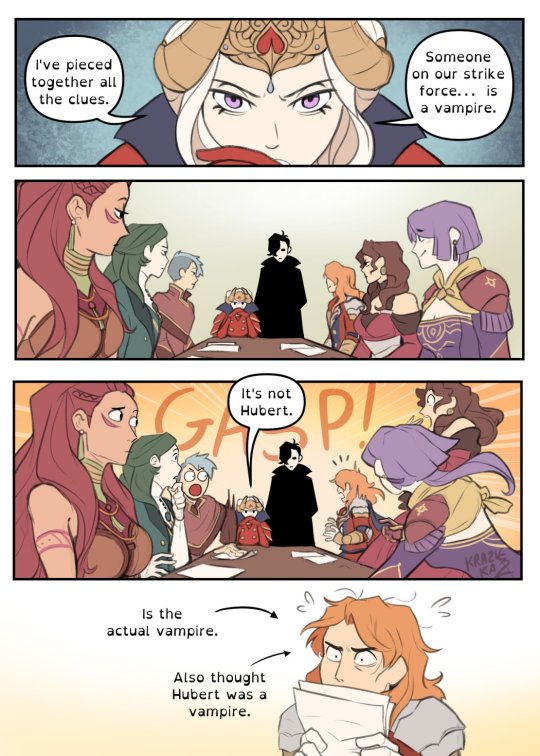
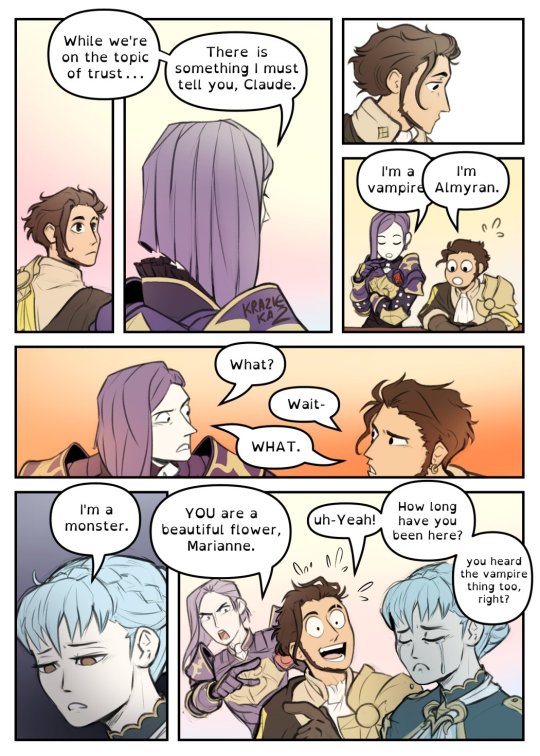
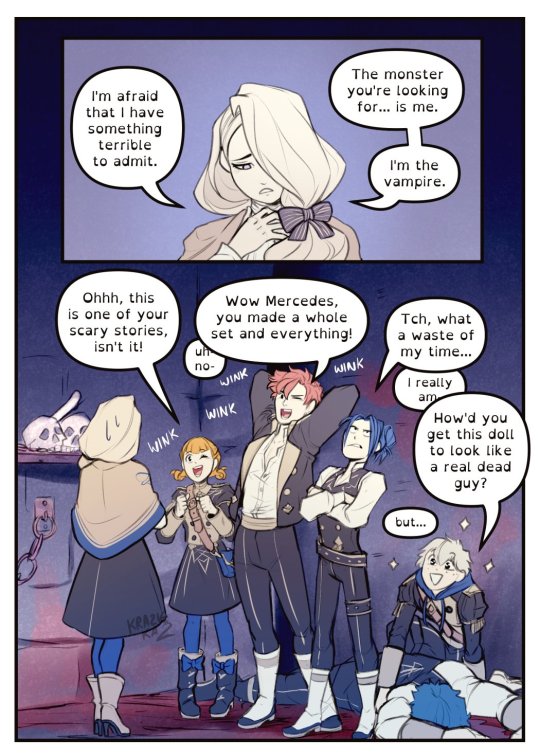

vamps.png
#this is my most popular twitter post AS IT SHOULD BE#my funniest work#still giggle at Balthus stealing the spotlight#fe3h#fire emblem#lorenz hellman gloucester#CONSTANCE VON NUVELLE#ferdinand von aegir#mercedes von martritz#black eagles#golden deer#blue lions#ashen wolves#carrying over my posts from twitter choo chooooo#Constance got the sun aversion#Mercedes can't see her reflection (Annie does her makeup)#Ferdinand has to be welcomed into rooms#Lorenz got the food allergies#This is my truth#Also Balthus is a werewolf#Yuri is a siren#and Hapi is the cursed girl that summoned them all#this has come up in the comments on reddit so for the record#Annette and Sylvain have figured it out and are covering for her#if you read this far now you know congrats#2022 art
5K notes
·
View notes
Text

personal work | oil and wax, powdered lead glass, 24k gold, rough opal, cut and polished opal, crushed fire opal, gilded porcelain
The Pale Horse is done! \0/
i am REALLY happy with how this turned out. and the original has a shimmer i wasn't able to get in the photo.
enjoy!
#artists on tumblr#trans artist#art#tumblr artist#small business#fantasy art#queer artist#reblogs are appreciated#artist spotlight#oil painting#traditional painting#traditional art#death’s horse#pale horse#horse
4K notes
·
View notes
Text

Highly suggest using it.^^
Follow me for more 🌿
#art blog#artistsupport#art help#beginner artist#artists on tumblr#art tutorial#artist spotlight#art tips#art tumblr#art ref
7K notes
·
View notes
Text
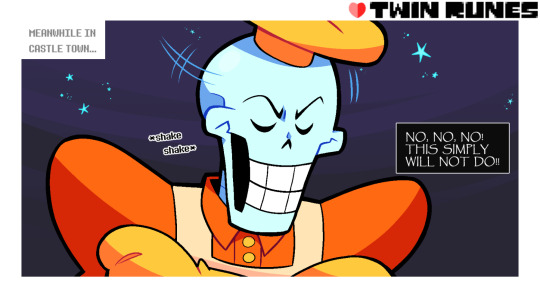
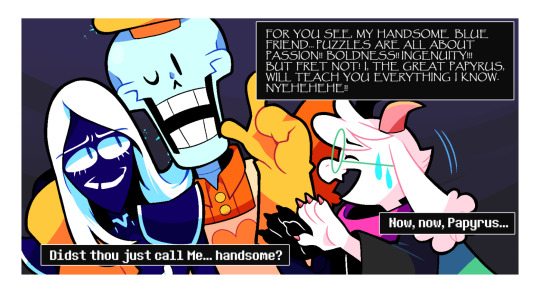
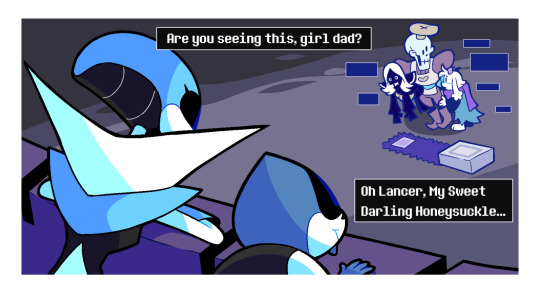

I'm sure Ralsei's gonna be fine... I hope
FIRST - PREVIOUS - NEXT
MASTERPOST (for the full series / FAQ / reference sheets)
#deltarune#deltarune fanart#deltarune comic#comic#twin runes#twin runes au#deltarune ralsei#undertale papyrus#undertale#crossover#utdr#roulxs kaard#lancer deltarune#queen deltarune#oh hey#this is the first comic without our main protagonists#time for the darkners to get the spotlight#it hasn't even been an hour and papyrus already adopted roulxs as his pupil#he'd make a greet teacher tbh#royal guard at work
6K notes
·
View notes
Text


Shane's excellent alien doodles from "Mystery Files: Uncovering the Alien Encounters of the US Government"
#watcher#watcher entertainment#mystery files#shane madej#special spotlight for the tralfamadorian in the first pic
1K notes
·
View notes
Text
Lets give a warm welcome to our contributors here at the Boatem Village Zine!





#boatem village zine#boatem zine#contributor spotlight#hermitcraft zine#hermitcraft season 8#zine updates#hermitcraft#boatem
1K notes
·
View notes
Text
Absolutely in love with how much depth 7x03 added to Bobby just by showing us what he must’ve been like when he was a young firefighter who hadn’t been promoted to captain yet. There’s the physical ability that reminds you that he was literally born and raised to do this job, and makes you imagine what stunts he was pulling when he was 30 years younger and hadn’t broken his back yet. The quick thinking and leadership skills that he’s been honing for his entire life. The level of calm and care he showed to the others that tells you that people must’ve felt so safe in his hands even on the worst day of their life. Everything about this episode showed just how good he was at this job and how he earned his promotion.
And then there’s the absolute devastation he felt when he lost Wes that suddenly makes it crystal clear how this job he loves so much set him on the path to alcoholism. The ease with which he shut off his own pain and stress to focus on moving forward and taking care of the others that makes it clear how nobody might’ve seen that he needed help with coping until it was too late. The fact that his actions were so reminiscent of Buck that Athena made the comparison out loud, and you understand that he’s so strict with Buck now because in his youth he was Buck and he knows how he turned out, so he does everything he can to give Buck the guidance and support he needs not to self-destruct like he did. You can also see in this episode how he knows that being good at the job is not enough and why he makes sure his team takes care of themselves just as much as the people they save.
He is a fourth-generation firefighter and this job has shaped so much of who he is from the day he was born and 7x03 just did such a good job of showing that
#we’ve seen glimpses of all of this but 7x03 shone a giant spotlight on it all for 42 minutes and it was beautiful#i’m literally so obsessed with this episode this was god tier bobby content#bobby nash#911#mine.#text#bobby#911 spoilers
1K notes
·
View notes
Text
The Writer's Guide to Authentic Wounds and Fatalities
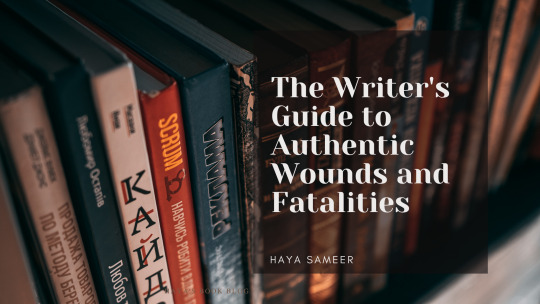
Writing fatal injuries in a story requires a delicate balance between realism and narrative impact. The portrayal of these life-altering events can evoke strong emotions in readers and shape the trajectory of your characters' journeys. In this blog, I will explore the intricacies of depicting fatal injuries in a manner that feels authentic, engaging, and respectful to the gravity of such circumstances. By understanding the nuances of fatal injuries, you will be equipped to craft compelling narratives that resonate with your readers.
Writing Fatal Injuries
When it comes to writing fatal injuries, it is crucial to approach the subject with care and accuracy. Fatal injuries carry immense consequences for your characters and can shape the trajectory of your story. By delving into the intricacies of portraying fatal injuries authentically, you can ensure that the gravity and impact of such events are effectively conveyed to your readers.
Choosing the right injuries for your story
Selecting the appropriate fatal injuries for your narrative involves considering various factors. Ask yourself: What purpose does this injury serve within the story? How does it affect the characters and the overall plot? Conduct thorough research to identify injuries that align with your story's context and resonate with the emotional journey of your characters.
For example, in a historical drama, you may research common fatal injuries during a particular era, such as battlefield injuries, diseases, or accidents prevalent at the time. In a crime thriller, you might explore the portrayal of fatal gunshot wounds or traumatic injuries resulting from violent encounters. By aligning the injuries with the context and themes of your story, you create a more immersive and believable experience for your readers.
Researching the mechanics of fatal injuries
To portray fatal injuries convincingly, it is essential to delve into the mechanics behind them. Understand the specific anatomical structures and systems involved, as well as the forces or mechanisms that can lead to fatal outcomes. Explore medical resources, consult experts if possible, and gather insights into the physiological and psychological implications of such injuries.
For instance, if your character suffers a fatal stab wound, research the anatomy involved, the potential organs affected, and the potential consequences such as internal bleeding or organ failure. By understanding the specific details and implications of the injury, you can describe the physical and emotional toll it takes on the character with greater accuracy and depth.
Depicting the immediate aftermath
When writing about fatal injuries, vividly describe the immediate aftermath to capture the intense emotions and physical realities. Consider the sensory details, the shock and disbelief experienced by characters, and the chaotic environment that often surrounds such events. Balancing realism with the needs of your story, create a scene that immerses readers and evokes empathy.
For example, if a character experiences a fatal car accident, you can depict the chaos at the scene, the character's disorientation, and the reactions of witnesses. Emphasize the sensory details such as the sound of screeching tires or the smell of burning rubber, creating a visceral experience for your readers.
Emotional and dramatic impact on the narrative
The impact of fatal injuries extends beyond the immediate moment. Explore the ripple effects on other characters, relationships, and the overall plot. Delve into the emotional responses, grief, guilt, anger, or determination that arises in the aftermath of loss. Utilize these emotional arcs to deepen character development and drive the narrative forward.
For instance, the loss of a loved one due to a fatal illness might lead to grief and strained relationships among the remaining family members. The emotional journey of a character grappling with guilt and seeking redemption after causing a fatal accident can become a central theme in your story. By delving into these emotional arcs and their consequences, you add depth and resonance to your narrative.
Writing Minor Injuries
While fatal injuries may capture our attention with their dramatic impact, it is equally important to pay attention to the portrayal of minor injuries in your writing. Minor injuries, though less severe, can still significantly affect your characters and contribute to the authenticity of your story. In this section, we will explore the art of depicting minor injuries, ensuring that they are not overlooked or trivialized. By delving into the nuances of minor injuries, you can add depth and realism to your characters' experiences.
Types of minor injuries to consider
When crafting your story, it is essential to consider a range of minor injuries that can occur. These injuries can include cuts, bruises, sprains, minor burns, or even minor fractures. Each type of injury carries its own unique characteristics, associated pain levels, and recovery processes. By understanding these distinctions, you can create accurate and believable depictions that resonate with your readers.
For example, a character who sustains a cut on their hand may experience sharp pain, the sight of blood, and the need for immediate first aid. On the other hand, a character with a sprained ankle may struggle with mobility, experience swelling, and require rest and care for a few days. By paying attention to these specific details, you can enhance the realism of your storytelling.
Conveying pain and discomfort
When writing about minor injuries, it is important to effectively convey the pain and discomfort experienced by your characters. Consider describing the sensation of pain, the throbbing or stinging feeling, and how it affects their daily activities or interactions. Showcasing the emotional impact of pain, such as frustration, irritation, or vulnerability, can deepen the readers' connection to the character's experience.
For instance, if a character suffers from a sprained wrist, you can describe the dull ache that persists, making simple tasks like typing or holding objects challenging. By capturing these small but significant moments, you immerse readers in the character's struggle and create a more realistic portrayal.
Balancing realism with narrative pace
While it is important to depict minor injuries realistically, it is also crucial to strike a balance with the overall pace and momentum of your story. Consider the significance of the injury within the larger context of your narrative. Some injuries may require more detailed attention and impact the plot, while others may serve as background elements. Adjust the level of detail and focus accordingly, ensuring that the portrayal of minor injuries aligns with the narrative's flow.
For example, a small cut on a character's finger may not require an extensive description unless it becomes infected or triggers an unexpected consequence. By aligning the portrayal of minor injuries with their narrative relevance, you maintain a consistent pace while still acknowledging their impact on your characters' lives.
Writing Bloodshed And Realistic Blood Loss
When writing about wounds and injuries, it is essential to consider the amount of blood loss your characters may experience. Realistic portrayal of bloodshed can enhance the authenticity of your scenes and immerse readers in the gravity of the situation. In this section, we will explore the factors influencing blood loss and techniques for accurately depicting it in your writing.
Understanding blood loss and its impact on the body
To authentically portray blood loss, it's crucial to have a basic understanding of how the human body responds to injury. Research the circulatory system and the role of blood in transporting oxygen and nutrients throughout the body. Consider the different types of blood vessels and their potential for bleeding when injured. This knowledge will help you create realistic scenarios and determine the appropriate level of blood loss for specific injuries.
Factors influencing blood loss in different injury scenarios
The amount of blood loss can vary depending on the severity and location of the injury. Factors such as the size of blood vessels, the rate of bleeding, and the body's ability to clot play a significant role. For example, a deep laceration in an artery will result in more substantial blood loss compared to a superficial cut on the skin. Consider these factors when describing injuries and their resulting bloodshed.
Techniques for accurately portraying blood loss in writing
There are several techniques you can use to convey the realistic impact of blood loss in your writing. Describing the color, consistency, and flow of blood can provide vivid imagery. You can also include physical symptoms such as dizziness, weakness, or fainting that may accompany significant blood loss. Additionally, consider the emotional response of your characters and how they react to the sight of blood or their own injuries.
By incorporating these techniques, you can create scenes that evoke a visceral response in readers and enhance the authenticity of your writing.
Bruises: Colors, Progression, and Pain
Bruises are a common result of injuries, and understanding how they form, change in color, and cause discomfort can greatly enhance the realism of your writing. By accurately describing bruises, you can bring depth to your characters' injuries and portray their healing process convincingly.
Understanding the stages and colors of bruises
Bruises go through distinct stages of color as they heal. Initially, they may appear red or purple due to the broken blood vessels beneath the skin. Over time, the color changes to blue, green, yellow, and eventually fades to a brown or yellowish hue. Understanding this color progression can help you accurately describe the age of a bruise and the healing process.
For example, a fresh bruise might be vivid purple, indicating recent trauma, while a fading bruise may have a yellowish tinge, suggesting that healing has begun. By incorporating these color details, you can add realism to your characters' injuries and track the passage of time within your narrative.
Depicting the progression of bruises over time
As bruises heal, they often change in appearance and size. Initially, a bruise may be small and localized, but it can gradually spread and become more extensive. Describing this progression can provide a sense of the healing process and the passage of time within your story.
For instance, a character who sustains a significant blow to the face may develop a bruise that starts as a small spot near the eye but expands to cover a larger area over the next few days. By accurately portraying the progression of bruises, you enhance the authenticity of your characters' injuries and their recovery.
Conveying the pain and sensitivity associated with bruises
Bruises can be painful, sensitive to touch, and affect a character's movement and daily activities. Describing the pain and discomfort experienced by your characters can create empathy and immerse readers in their physical ordeals.
Consider conveying the tenderness of a bruise when pressure is applied, the throbbing sensation, or the limitation of movement due to the pain.
Remember The Side Effects
Injuries, whether minor or severe, often come with a range of side effects that can significantly impact your characters' lives. These side effects can extend beyond the physical realm and encompass emotional, psychological, and social aspects.
Physical side effects
Injuries can have profound physical side effects that go beyond the immediate pain and discomfort. Consider the potential consequences such as limited mobility, impaired coordination, chronic pain, or the need for assistive devices like crutches or braces. Describing these physical side effects can add depth to your characters' struggles and provide a realistic portrayal of their healing journey.
For example, a character who sustains a leg injury may experience difficulty walking, require physical therapy, or have long-term complications that affect their day-to-day activities. By addressing these physical side effects, you create a more nuanced depiction of the aftermath of injuries.
Emotional and psychological side effects
Injuries can have a profound emotional and psychological impact on characters. They may experience fear, anxiety, trauma, or a loss of confidence. Consider how the injury affects their self-image, relationships, or mental well-being. Explore the emotional journey your characters undergo as they navigate the aftermath of their injuries.
For instance, a character who survives a near-fatal accident may develop post-traumatic stress disorder (PTSD) and struggle with recurring nightmares or panic attacks. By incorporating these emotional and psychological side effects, you can deepen the complexity of your characters and their responses to traumatic experiences.
Social implications and changes
Injuries can also lead to significant social changes for your characters. They may face challenges in their personal relationships, encounter stigma or discrimination, or experience changes in their roles or identities. Explore how the injury affects their interactions with others and their sense of belonging in the world.
For example, a character who sustains a facial injury may encounter judgment or stares from others, leading to self-consciousness or isolation. By addressing the social implications and changes resulting from injuries, you can create multi-dimensional characters and explore the impact of their injuries on their social dynamics.
By incorporating these various side effects into your writing, you bring depth and authenticity to your characters' experiences and showcase the wide-ranging impact of injuries.
Conclusion
Writing authentic wounds and fatalities requires attention to detail and a deep understanding of the physical, emotional, and psychological aspects involved. By following the guidelines and exploring the subheadings discussed in this guide, you can create compelling and realistic portrayals of injuries in your writing.
Remember to conduct thorough research on the specific injuries you want to depict, understanding their mechanics, symptoms, and potential outcomes. Consider the immediate and long-term effects on your characters, both physically and emotionally. Incorporate sensory details to immerse readers in the experience, describing the pain, bloodshed, colors of bruises, and the progression of healing.
Additionally, don't forget to address the side effects that injuries can have on your characters' lives. Explore the physical limitations, emotional struggles, and social implications that arise from their injuries. By delving into these aspects, you can create well-rounded characters and compelling narratives that resonate with readers.
I hope this blog on forging epic battles will help you in your writing journey. Be sure to comment any tips of your own to help your fellow authors prosper, and follow my blog for new blog updates every Monday and Thursday.
Looking For More Writing Tips And Tricks?
Are you an author looking for writing tips and tricks to better your manuscript? Or do you want to learn about how to get a literary agent, get published and properly market your book? Consider checking out the rest of Haya’s book blog where I post writing and publishing tips for authors every Monday and Thursday! And don’t forget to head over to my TikTok and Instagram profiles @hayatheauthor to learn more about my WIP and writing journey!
#hayatheauthor#haya's book blog#haya sameer#haya blogs#writers on tumblr#writer community#writer tools#writer blog#writer stuff#writer wednesday#writer tips#creative writing#writers of tumblr#writerscommunity#writeblr#writing community#writer spotlight#writer things#writing prompt#writing tools#writing stuff#writing#writing life#writing inspo#writing help#writing advice#writing inspiration#writing ideas#writing things#writing tip
4K notes
·
View notes
Photo


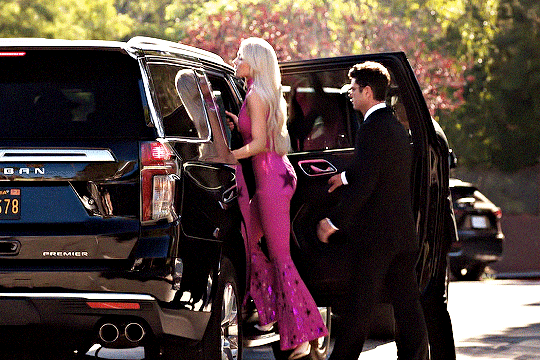

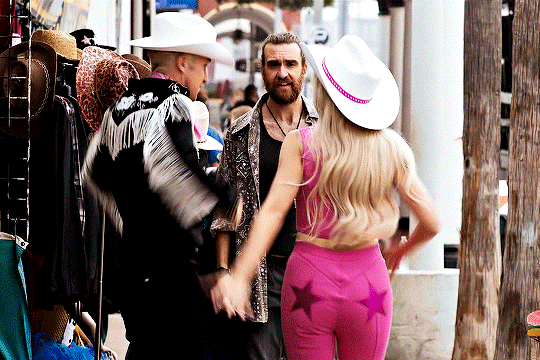
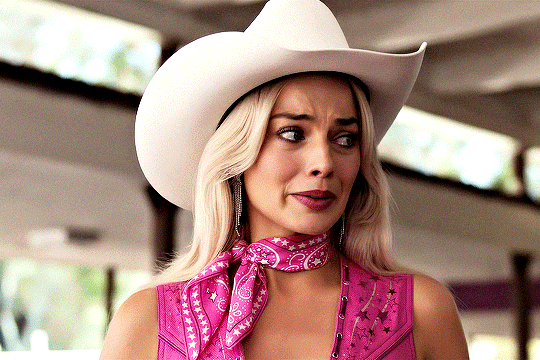


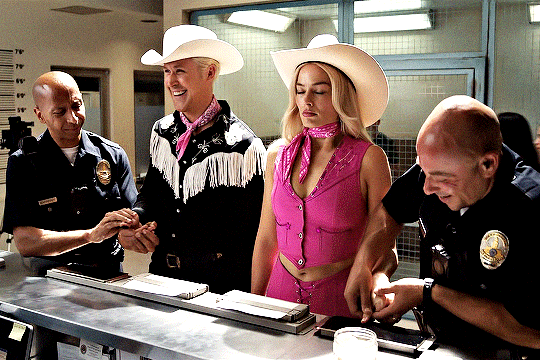
BARBIE, 2023
DIR. BY GRETA GERWIG
#barbie#barbie the movie#filmedit#filmgifs#moviegifs#dailyflicks#fyeahmovies#cinemasource#greta gerwig#margot robbie#ryan gosling#barbie movie#99#90#gifs#*f#*#*5k#im obsessed with this outfit <3#it deserves all the spotlight
5K notes
·
View notes